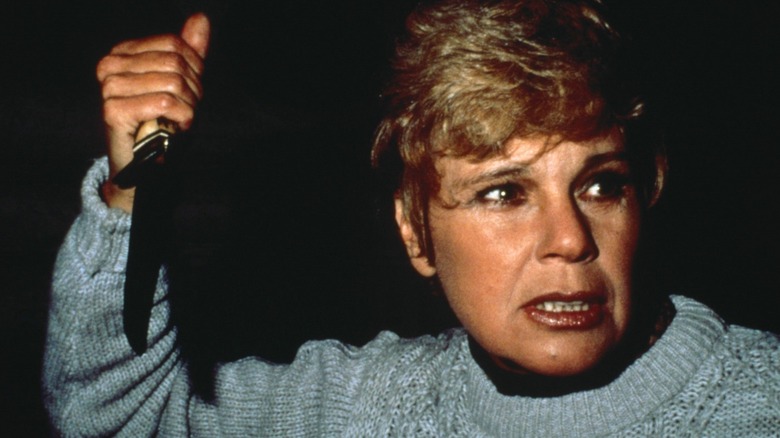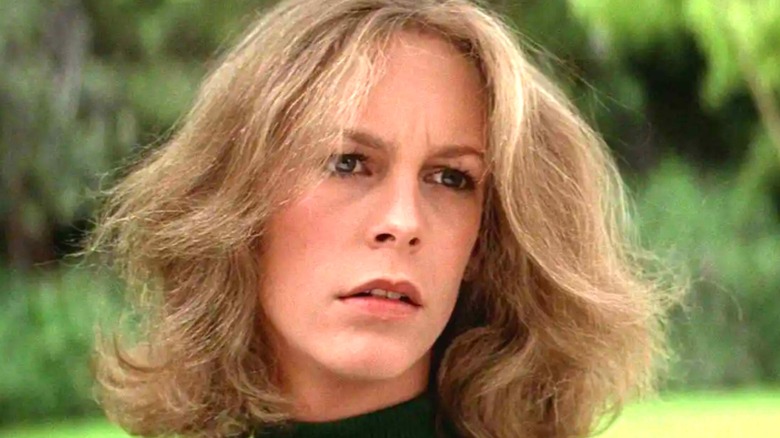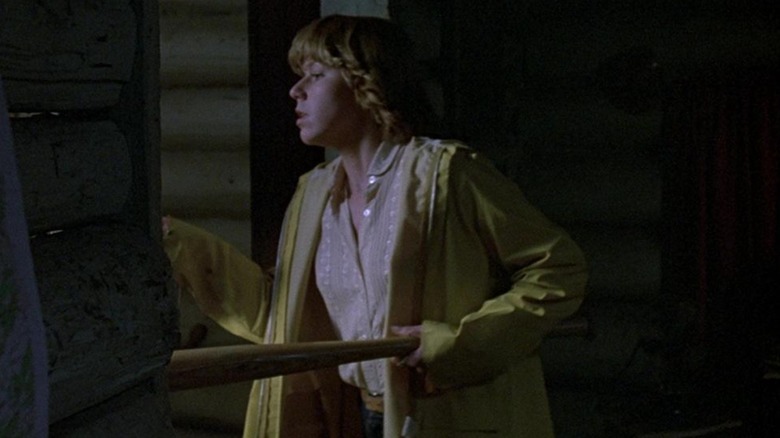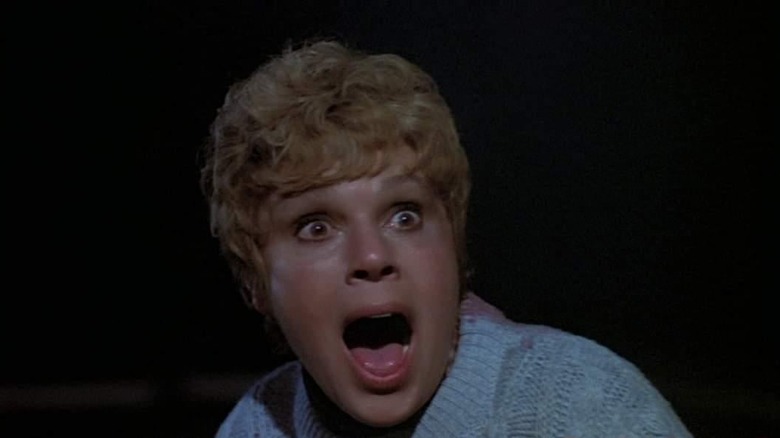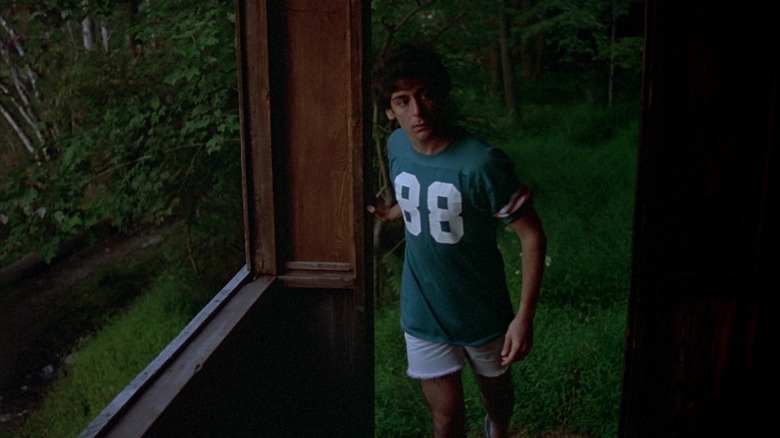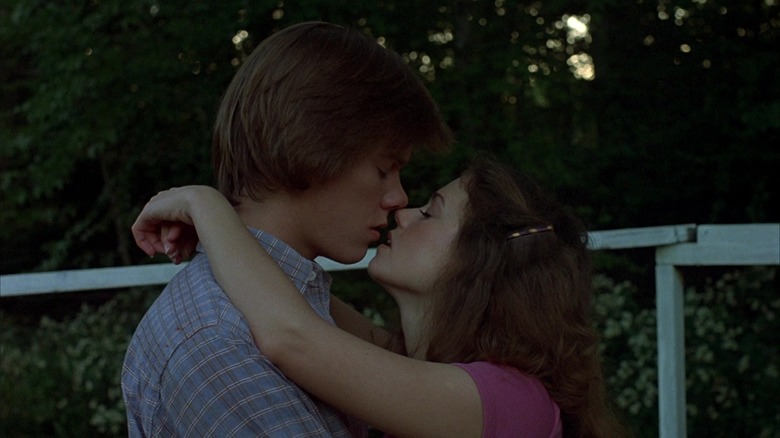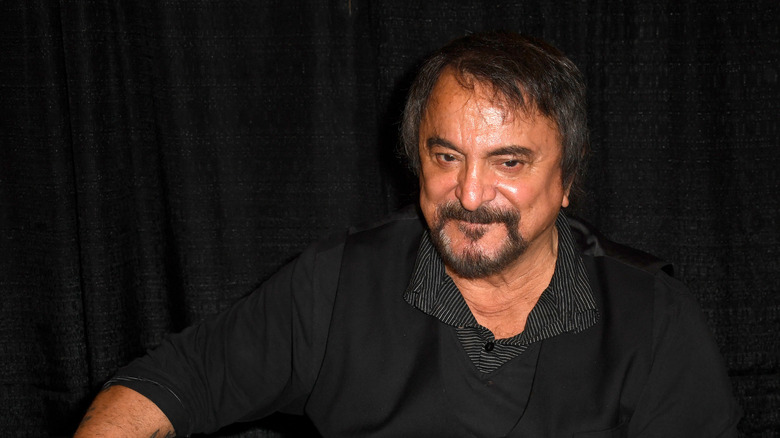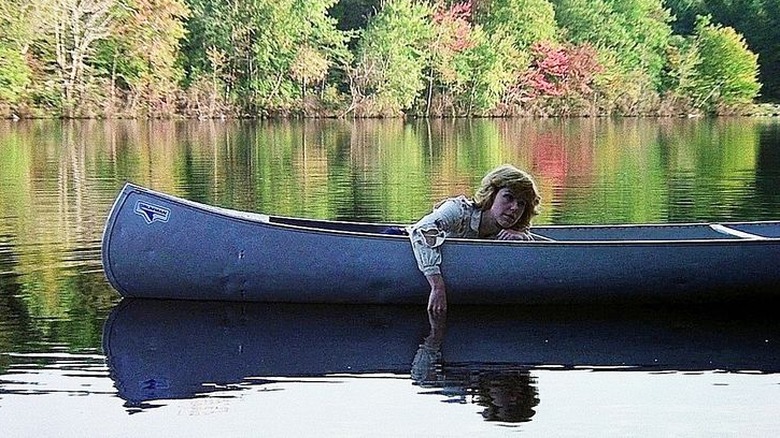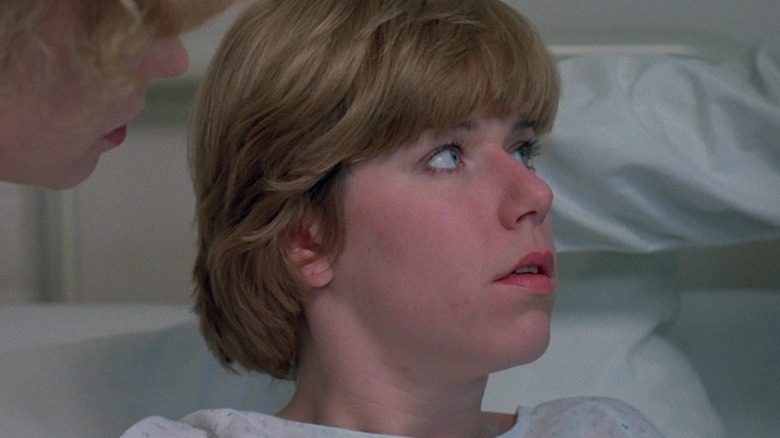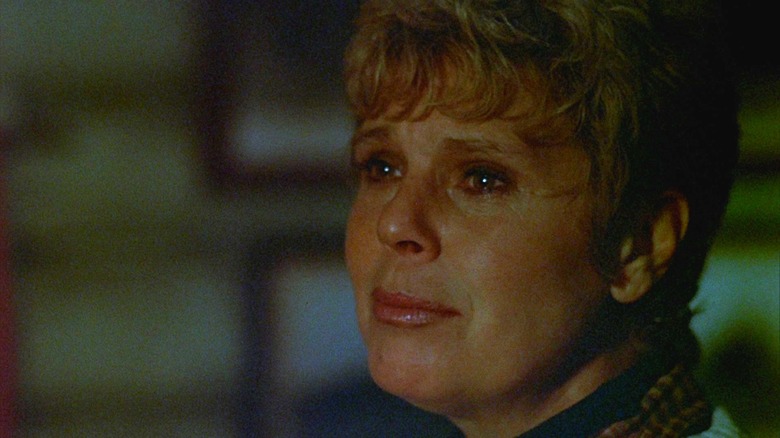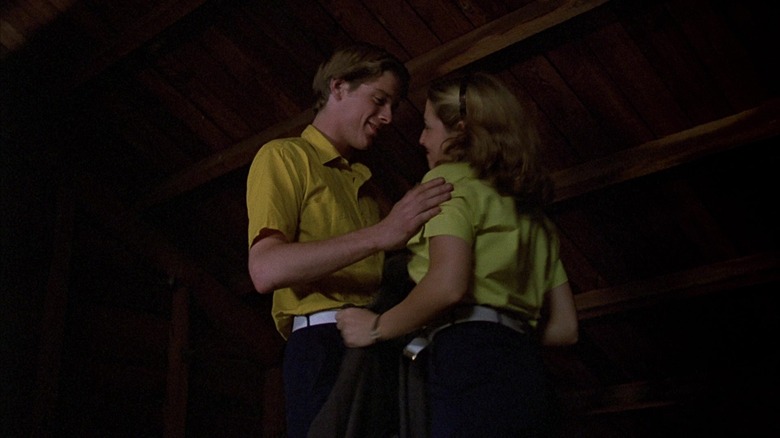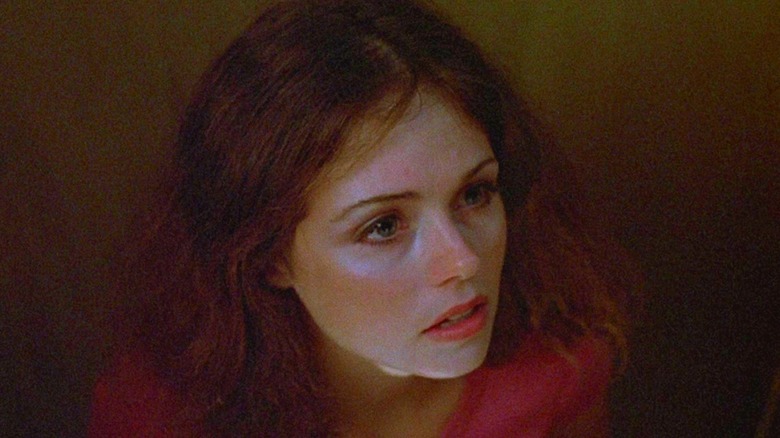The Untold Truth Of Friday The 13th
For many slasher fans, there's nothing quite like the thrill of watching a faceless monster chase its next victim, and the unfortunate target flailing, falling, and seemingly doing everything they can to unalive themselves. Maybe it's the thrill of the fright, or perhaps there's something oddly satisfying about mentally calculating where the victims go wrong, as one by one they succumb to the inevitable slaughter that awaits them. In a genre that's positively overrun with final girls and sequels these days, every new film owes at least some credit to the genre trailblazers of the late '70s and early '80s, with films like "Halloween," "A Nightmare on Elm Street," and of course, "Friday the 13th" still proving influential today.
Every masked psychopath has its origin story, but the one that led to the development of Jason Voorhees and his revenge-driven mother is one of the wildest in the world of horror. From producers flirting with plagiarism to prosthetic-filled pizza ovens, there's a lot to dive into. Hang on to your hockey mask and head into Camp Crystal Lake as we look at the untold truth of "Friday the 13th."
The film was reverse-engineered from Halloween
No slasher flick would be complete without the tropes we've come to know and love in the genre: a (usually) masked psychopathic killer, a signature weapon, a series of victims making every possible bad decision, and a final girl. It's a formula that works, which is why the makers of "Friday the 13th" were more than happy to copy it from "Halloween." According to screenwriter Victor Miller, who penned the film, that's exactly what he and director Sean Cunningham set out to do.
The budget for "Halloween" was little more than $300,000 and it grossed more than $47 million worldwide, so it is hard to blame the makers of "Friday the 13th" for spying a potential cash cow. For Cunningham, who was best known at that point for the kids-and-sports films "Here Come the Tigers" and "Manny's Orphans," replicating the successful 1978 horror film seemed like a fine idea. After putting out the children's films to limited success, Cunningham knew his investors weren't ready to cough up cash for more of the same. According to Miller, Cunningham's screenwriter friend, the director rang him up with a proposal. As Miller recounted to Uproxx, Cunningham told him, "Halloween is making a lot of money, let's rip it off."
Miller, who says he doesn't consider himself a horror person, watched "Halloween" with one goal: to reverse engineer it. The job proved easy enough, with Miller crediting John Carpenter and Debra Hill for creating such a clear and easy-to-follow horror film — a perfect template for his own.
The original title was A Long Night at Camp Blood
The title "Friday the 13th" would prove so iconic that producer Frank Mancuso Jr., who took over the film series with "Friday the 13th Part 2," would use it for a completely unrelated syndicated supernatural horror series in 1987. But this stroke of titling genius almost wasn't to be, and the series narrowly avoided getting saddled with the much more cumbersome title "A Long Night at Camp Blood."
According to Marc Blake and Sara Bailey's book "Writing the Horror Movie," Victor Miller's viewing of "Halloween" helped him develop the beginnings of a future hit film. But his working title, "A Long Night at Camp Blood," didn't go over well with Sean Cunningham, who had something a whole lot catchier in mind. Relating the process to Esquire, Cunningham says inspiration struck while he was working on his 1978 film "Manny's Orphans." He was freewriting a list of titles for the soccer flick on a yellow notepad when he suddenly wrote down the phrase "Friday the 13th." Even if it wouldn't work for that film, he knew right away the title was a winner. As Cunningham put it, "I had a picture called Friday the 13th, and I knew how to sell that."
Miller, who had already started to draft the film, wasn't entirely sure the title would work, seeing as there was no reference to the cursed date in the film at that point. But he reworked the film to accommodate the new title, and the rest is history.
The producers were hyping the film before it existed
For a guy whose claim to fame at the time was a couple of G-rated flops, Sean Cunningham knew he'd struck gold with his latest idea before it was even written. He was so sure of it that he was willing to take out a full-page advertisement in Variety before the film was fully formed. The ad, which came out on July 4, 1979, promised the slasher would be "The Most Terrifying Film Ever Made."
But it wasn't just about generating buzz — for the director, it was also a test. According to Cunningham, he needed to be certain his title wouldn't constitute a copyright violation. In the pre-Internet era, no one wanted to risk making a blockbuster hit only to get slapped with a massive copyright infringement lawsuit down the road. As Cunningham told Uproxx, "What I wanted to see is if some lawyer was going to write me a letter saying, 'You can't do that, we own the title.'" That letter never came. What did come, however, was a whole lot of interest from distributors inquiring about the rights to the film, serving as proof of concept that the team's great idea had wider appeal. Now the only thing left to do was make it.
Tom Savini and his assistant stayed at the camp
It's hard to imagine a more immersive filmmaking experience than actually staying at Camp Crystal Lake while filming there, but that is exactly what prosthetic makeup effects artist Tom Savini decided to do. The movie was filmed at a New Jersey Boy Scout camp called Camp No-Be-Bo-Sco, a 380-acre camp founded in 1927 that is still active today. In fact, fans of the film series can take a tour of the grounds or stay overnight if they're brave enough.
During the month-long filming of "Friday the 13th," Savini and his assistant Taso N. Stavrakis decided to camp out on the grounds instead of staying in a nearby hotel or motel like the rest of the cast and crew. Savini recalled his time at the camp fondly in an interview with Smithsonian Magazine and that it was an absolute blast. While there, he and Stavrakis had plenty to entertain themselves with. When they weren't cooking up recipes for fake blood, they were riding their motorbikes through woodland trails. They even had a Betamax video player, which Savini says they used to watch films like "Barbarella" and "Marathon Man." They even used the camp's pizza ovens to bake some of the latex appliances that helped pull off a few of their grisliest death scenes.
Kevin Bacon only got one take on his death
In the era before CGI, filming a complicated or particularly gory death scene was often even more complicated than it is today. Frequently, and particularly when it came to low-budget films like "A Nightmare on Elm Street" and "Friday the 13th," this meant actors would only get one take with some of the more gruesome special effects. For a young Kevin Bacon, his single-take run at Jack's death scene left a bad taste in his mouth ... literally. The scene — which requires viewers not to think too closely about the physics of his murder — finds a post-nookie Jack firing up a joint in his bunk when Jason's mom thrusts an arrow upward through his mattress and into his throat.
As Bacon told Sirius XM, he had been told there was only one prosthetic neck and chest to use, which meant he would only get one chance to shoot the scene. While filming, Bacon sat on his knees underneath the prosthetic chest on the bed with his neck sticking through a hole, and a special effects technician underneath the bed pumped the blood through. But things went sideways when the hose broke mid-shot, forcing the tech to blow the blood manually in the heat of the moment and this sent some of it into Bacon's mouth. It was only then that he learned Savini's fake blood recipe contained Kodak Photo-Flo, a poisonous type of film developer. At least they got the take, and Bacon lives to tell the tale.
Tom Savini drew on his experiences in Vietnam for his practical effects
Before Tom Savini came along, on-screen special effects were often pretty campy and unrealistic. However, Savini developed a reputation for bringing realism to the screen — something he says goes back to his time in Vietnam. As a combat photographer, Savini's wartime role required him to document damage both to military equipment and human lives. As he told the Post-Gazette, "Through my lens, I saw some hideous [stuff]. To cope with it, I guess I tried to think of it as special effects."
Those horrors also gave him a rather grisly insight into the human body, something that he's used to seal his reputation for anatomical correctness. Savini also uses the feelings he experienced in Vietnam as a metric, emphasizing that if his special effects don't make him feel like the real thing did, then they aren't realistic enough. By the time he began work on "Friday the 13th," Savini had already begun to develop a reputation for this style of practical effects, receiving a Saturn Award nomination for his work on "Dawn of the Dead" in 1980. These days, many horror fans still consider Savini one of the best practical effects experts in the industry.
Some of the cast and crew find its success shocking
Even if the film's creators felt like they were onto something when they took out that ad in Variety, they still find themselves shocked that the bet paid off. Things took off pretty quickly from that point and they sped through the production without putting much effort into multiple drafts or polishing up the dialogue. Once they started shooting in September it didn't take long for the film to come together, with Sean Cunningham telling Uproxx, "The whole thing was done, pretty much a dead run."
According to The Week, Cunningham still can't believe the film ended up as big as it did. At the end of the day, he was just making his own version of another successful horror film, emphasizing, "The movie has no emotional impact on me at all. The characters were thin at best." In the Uproxx oral history, actors Kevin Bacon and Betsy Palmer say they also found the film's success surprising, with Adrienne King recalling Palmer's shock decades later at how well-received the film still is among fans at conventions.
A few of the cast and crew were penniless when they made it
It's hard to overstate how truly life-changing a film "Friday the 13th" would prove to be for at least a few members of its main cast and crew. For Sean Cunningham, it was a desperate attempt to get back in black after a couple of poor-performing films. Victor Miller was so hard up for cash at the time that the week before the film's opening, he had tried to sell his blood to a Bridgeport, Connecticut antibody study for $25 a pint — a study he was disqualified from owing to a lack of enough antibodies. As he told Uproxx, "Basically, I was just trying to survive and so was Sean. We were facing what is best known as the condition of being penniless."
Kevin Bacon, who had landed his first role as a brutally hazed pledge in "Animal House," had not seen his career take off yet and found himself back to waiting tables in New York City to support his stage career. He didn't love the idea of acting in a low-budget horror flick like "Friday the 13th," but he found himself desperate for rent money. He said to Uproxx, "I was literally hand to mouth. Not starving but always a week and a half away from starving."
They had a hard time getting someone to play Jason's mom
As Pamela Voorhees, Betsy Palmer perfectly inhabited the spirit of Jason's rage-filled mother. But Palmer wasn't Sean Cunningham's first pick for the role. The honor was originally meant to go to Estelle Parsons, who had won an Oscar for her work on "Bonnie and Clyde" in 1968, but the script proved too violent for her taste. The director contacted Palmer next, but she wasn't especially thrilled about doing a horror project, either, and probably wouldn't have taken the gig if not for a perfect twist of fate.
As Cunningham was casting the film, Palmer's beloved ride, a Volkswagen Scirocco, needed some costly repairs — about $10,000 worth. Not sure if she'd rather shell out that much cash or just pick up a new whip, she decided to take the night to think about it. As luck would have it, her agent called to offer a job in nearby New Jersey that would only take a few weeks to shoot, but it was a horror flick. When he told her the pay — $10,000 — she took the job as a quick side hustle, mainly because she was convinced no one would ever actually see the thing.
Jason was intended to stay dead
When Sean Cunningham and Victor Miller were putting together "Friday the 13th," they could have had no idea the film would spawn nearly a dozen sequels or that Jason would end up becoming the villain of the series. As viewers, it's easy to forget that Mrs. Voorhees was always the original villain or that her motivation was not psychopathy but her enduring love for her son. And in light of that motivation, it really only makes sense if Jason stays dead.
Although we tend to associate Jason with his hockey mask, it doesn't even exist until the third film. In the original movie, Jason is a disabled child whose only crime is getting bullied and then daring to go swimming with a bunch of incompetent camp counselors around. For Miller, the story was always about a hard-working single mom and her son, which allowed him to write a complex villain who kills out of love for her child. To him, bringing back Jason negates everything his mother did in the film since he was apparently alive all along, which means in Miller's headcanon, every appearance of the hockey-masked foe is imaginary.
Critics were so angry about the film they took action
Given the way "Friday the 13th" was produced and its lightspeed production, it shouldn't come as much of a shock that critics hated it. But some of them hated it so much that they had some unusually strong reactions. Upon seeing the film, famed critics Gene Siskel and Roger Ebert caught so many feelings that their response has been the subject of lengthy analyses. Siskel even intentionally spoiled the ending in hopes it would deter folks from seeing the film. Worse, he prompted readers to harass the executives at Paramount and poor Betsy Palmer ... because women in show business didn't already have enough to deal with in the '80s. Later that year, the two critics even produced a sensationalized episode of their show devoted to the "disturbing new trend" of women's portrayal in slasher films.
Other critics' responses were equally absurd. The Hollywood Reporter called the film "blatant exploitation of the lowest order," while The Boston Globe derided it and said they "wouldn't wish 'Friday the 13th' on anyone." While it would take film critics a few years to grasp the concept of the horror camp factor, most viewers didn't take nearly as long to catch on. Partly fueled by the bad reviews, audiences flocked to the gory spectacle, and before long, a hit horror franchise was born.
